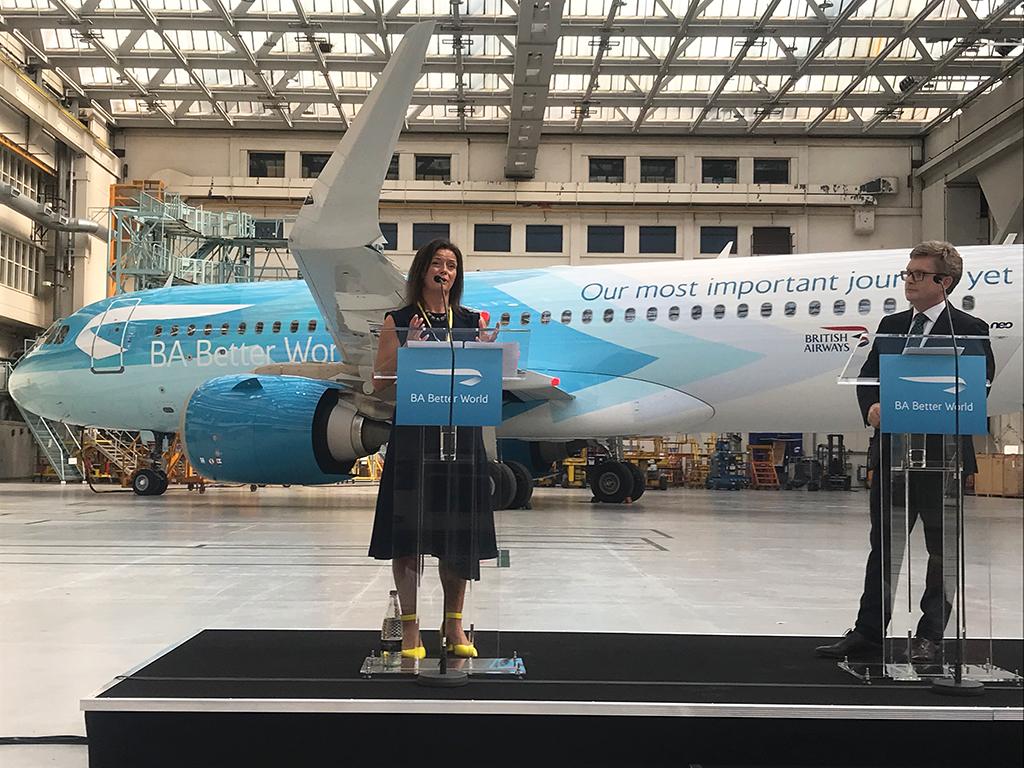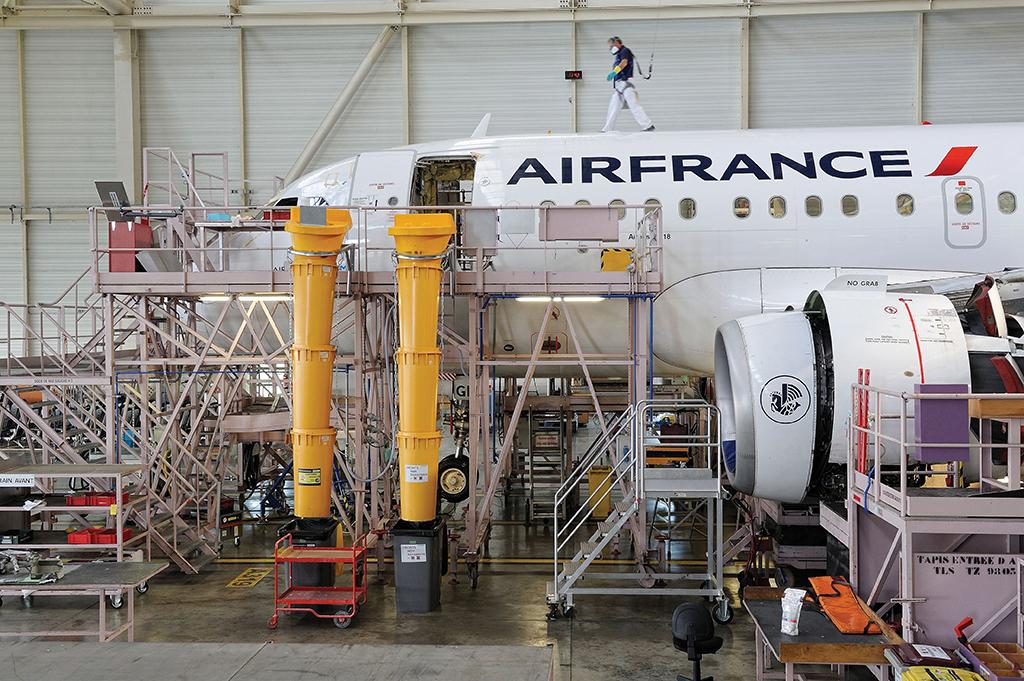Steps Toward Sustainability For MROs Require Greater Collaboration

The pressure is on. Sustainability has shot up on the agenda, and new industry initiatives are being announced every day. But is the MRO sector keeping up—-and are airline expectations about to shift?
It is no coincidence that the first post-lockdown events have focused on sustainability. On Sept. 7, British Airways (BA) invited journalists to its London Heathrow hangars to unveil an eco-liveried Airbus A350. On Sept. 22, the European Regions Airline Association (ERA) held a Sustainable Regional Aviation Forum in Las Palmas in the Canary Islands. On Sept. 28, the Air Transport Action Group (ATAG) staged its annual Global Sustainable Aviation Forum. And on Oct. 4, the International Air Transport Association (IATA) announced a new net-zero goal. The list goes on.
Standing in front of the freshly painted “BA Better World” A350, BA CEO Sean Doyle told a gathering of socially distanced journalists: “We want every aspect of our business to consider sustainability.”
BUSINESS SHIFT
When asked what this means for MROs, BA Head of Sustainability Carrie Harris said: “In terms of suppliers, this marks a shift in the way that we’re doing business. It’s fundamental to our core business strategy and our core business model, so no stone is left unturned.”
All of BA’s main-base MRO facilities are powered with renewable energy. The airline uses electric pushbacks and tight waste-management procedures. These efforts are going to be intensified this year.
“Especially for aircraft maintenance, we need to be careful about contaminated materials, disposal and segregation of products. All of that we manage through our IEnvA environmental management system, which is in line with ISO 14001 environmental standards,” Harris said.
IEnvA is IATA’s environmental assessment program. So far, Aer Lingus, Airlink, BA, GOL, LATAM Colombia and Vueling have registered for Stage 1, which covers corporate activities and flight operations. Stage 2, however, notably includes MRO functions. Air Canada, Air Canada Rouge, Air New Zealand, Icelandair, Qatar Airways and South African Airways have already signed up for the MRO component of IEnvA Stage 2.
Expectations are growing—and they go beyond the airlines listed above.
Air France-KLM Group has committed to zero ground emissions by 2030, including in-house MRO operations. “This trend is obviously becoming stronger and stronger, and our customers are increasingly aware of our actions on this subject,” says Derk Nieuwenhuijze, vice president for digital, marketing and communication at Air France Industries–KLM Engineering & Maintenance (AFI KLM E&M).
As an airline MRO, AFI KLM E&M’s sustainability strategy already covers areas such as infrastructure design, creative use of IT and recycling plastics to feed 3D printing as well as component and engine-part repairs.
“We are analyzing and implementing technologies to reduce environmental impact wherever possible,” Nieuwenhuijze says. “Our engine shop in Amsterdam has a closed energy loop, storing warmth in the ground in summer and regaining that in winter.”
AFI KLM E&M also came up with the Prognos predictive maintenance suite, which uses big data to improve operational stability and optimize fuel consumption. This indirectly cuts flight-recovery positioning and eliminates fuel ditching for quick returns.
SUPPLIER RIPPLE EFFECT
However, this level of environmental responsibility also creates strong expectations for AFI KLM E&M’s suppliers. “Our responsibility does not end at the door of our hangars. We use [sustainability ratings startup] EcoVadis for our suppliers to ensure high standards of social and environmental responsibility throughout the chain,” Nieuwenhuijze says.
Likewise, Sampo Paukkeri, head of aircraft maintenance at Finnair, says his airline’s MRO suppliers are expected to have a fully documented environmental policy, a high level of environmental awareness and to comply with Finnair’s sustainability policies and supplier code of conduct.
“We have included our own environmental requirements into our maintenance contracts, and we expect our MRO suppliers to follow them,” he says. “We also expect them to actively work on reducing the environmental load of their production and transport chain.”
It is not only a European push. Moving east, AirAsia also has a strong sustainability culture. “This is not just something expected of us by regulators and other stakeholders; it is something we have started to invest in more systematically, including through our MRO suppliers,” says Mahesh Kumar, CEO of Asia Digital Engineering (ADE).
ADE is a wholly owned AirAsia Group subsidiary that provides line and base maintenance for group and third-party airlines. “We prioritize working with MRO suppliers which have a clean track record in waste management, provide options for us to reuse and recycle, and produce creative options on carbon offsetting,” Kumar says.
Like Finnair, AirAsia requires its suppliers to adhere to a code of conduct that covers environmental responsibility. “AirAsia Group suppliers are also to identify, set targets and implement action plans for reducing environmental impacts in the areas of water, wastewater, energy, greenhouse gas emissions, waste and packaging, to support delivering the needs of AirAsia’s sustainability commitments,” Kumar says.
It appears it is not enough just to be sustainability-compliant. Airlines are now expecting MROs to be proactive.
As an MRO, ADE is also taking its own action to move toward sustainability. Aircraft performance is being improved through exterior cleaning and engine wash. Data is being used to optimize APU utilization, reducing running hours, carbon emissions and noise. ADE is also going fully digital and paperless as well as upcycling used materials.
RECYCLING
“AirAsia discards up to 5,000 uniforms, 100 safety vests and 200 seat belts every year. All that amounts to about 3.8 metric tons (3,800 kg) of fabric destined for the landfills,” Kumar says. “Through AirAsia Group’s philanthropic arm, AirAsia Foundation, we turned discarded materials such as the non-biodegradable life jackets, aircraft seat belts, leather seats and more into usable lifestyle items such as bags, animal toys, fashionable wear and more.”

Kumar believes MROs will come under increasing pressure from airlines to step up their game. “MROs are expected to offer options of carbon offsetting in creative ways. We definitely see the shift in expectations for sustainability requirements,” he says.
The stage is set. Expectations are clearly growing, but the vast majority of sustainability initiatives are being led by other industry players. Airlines and OEMs are very present. Where are the MROs?
Asking this question of various executives and industry bodies draws a blank. “We have not had the bandwidth to look at MRO,” says Haldane Dodd, acting executive director of the Air Transport Action Group, which is behind the Waypoint 2050 global aviation sustainability road map.
Airlines for Europe (A4E), the lobbying group for the major European airlines, says the European Destination 2050 action plan does not contain anything very MRO-specific. “I checked with the study consultants as well, and they don’t recall further discussing this topic during interviews with suppliers or during the workshop,” an A4E spokeswoman says.
Curiously, some MRO stakeholders are not seeing much action on this front either.
MISMATCH
“We have not observed any significant shift for now, although we have seen more interest in the [environmental, social and governance (ESG)] practices and policies of the suppliers from some customers at the tender or inquiry stage,” ST Engineering’s commercial aerospace president Jeffrey Lam says.
ST Engineering’s eco-initiatives include a closed-loop EcoPower engine-wash system that collects, filters and reuses the water, leaving only filtered elements as waste. This is just one part of the company’s plan to reduce waste, power and water use.
“In Singapore, solar panels are currently installed at two of our three aerospace facilities, which help to generate 4.1 megawatts of clean energy to meet about 10% of our electricity needs. By the end of 2021, we will have solar systems installed at all of our aerospace facilities in Singapore to meet 30% of our needs, while our other global facilities in regions such as China will also increasingly adopt the use of solar energy,” he says.
However, when asked whether he has seen signs of MROs coming together on sustainability initiatives, Lam replied “not at the moment.”
Others are seeing a similar picture. “Do you see the shift in expectations from customers? No,” says Sarah MacLeod, executive director at the Aeronautical Repair Station Association (ARSA). “Have you seen any signs of the MRO industry itself coming together [on sustainability]? No.”
Like Lam, MacLeod thinks MROs may be receiving more queries about sustainability policies but not to the point of them making a noticeable shift.
MORE DATA
To explore this further, ARSA polled its members on their sustainability efforts, asking about eco-initiatives and whether they had witnessed any change in customer expectations. Operations Vice President Brett Levanto says the body’s members “fervently consume” ARSA content, but this three-week survey yielded only four responses.

“When this happens with our ‘quick questions,’ we generally interpret it to mean that the topic doesn’t resonate, i.e., sustainability isn’t front of mind for ARSA members,” Levanto says. “Obviously, I can’t guarantee what nonresponse means. At the least, it shows that any sustainability efforts aren’t happening in a way that’s front and center for the folks on the shop or hangar floor. For the many small repair stations we count among ARSA members, it’s probably much further out of focus.”
None of the four ARSA respondents reported sustainability requirements in tenders or contracts. “With four responses, that’s not really a reliable sample, but I think it’s reflective of the larger lack of passion for the subject,” he says.
Levanto suggests that the disconnect could lie in company size, pointing to the collision between “well-meaning (and marketing-driven) bigger organizations” and ARSA’s small business-dominated membership, which is focused on near-term challenges.
This is also an emerging conversation, which perhaps explains the disconnect between what the airlines say they want and what the MROs are experiencing in practice.
David Stewart, partner at consultancy Oliver Wyman, noted that MROs form part of airline “Scope 3” supply chain emissions. “Airlines will come [to MROs] and say, ‘How are you helping us with our Scope 3?’ Then the question [for MROs] is, ‘What are you doing about your own Scope 3 emissions?’”
This fits with the airline comments about their sustainability expectations going beyond the MRO and into MRO supply chains. However, airlines are perhaps still so focused on their Scope 1 direct-flight emissions that they have not had time to look too hard at Scope 3 yet, as suggested by A4E and ATAG.
“It’s not very mature, that debate, so [this topic] is timely,” Stewart says. “Most people have made some progress about understanding what their Scope 1 [direct-emissions impact] is and what their Scope 2 [energy-use impact] is, because it’s more in their direct control. Very few people have been able to develop a strategy about what their Scope 3 is.”
Deloitte defines Scope 3 as the part where it “gets tricky.” This resonates with Stewart’s comments. “Emissions-wise, Scope 3 is nearly always the big one,” Deloitte says.
Then there is the diversity of MRO. “An engine OEM that’s providing maintenance has a very, very different sustainability discussion to somebody who’s doing airframe maintenance with lots of labor and a hangar,” Stewart says. The engine OEM sustainability discussion seems well-advanced, but for independent line- and airframe-maintenance, the discussion appears to be in its infancy.
“They’re going to be asked this question, about what they’re doing for sustainability, and therefore they need to have an answer,” Stewart says. “The number of levers that an MRO has got to pull to reduce its emissions is relatively limited. I think the other interesting question is: Can an MRO afford to invest significantly?” But this question also arises: Can they afford not to invest if funding becomes conditional on green credentials?
MONEY
“The banks won’t say, ‘Oh, you’ve got a target; here’s some money.’ It will be, ‘Well, what’s the plan, how are you going to get there, how are you going to measure success?’ So it’s all going to be necessary,” Stewart says.
MacLeod from ARSA shifted the debate further. “Aviation acts like it’s this special thing. There’s hardly anything in aviation that wasn’t used in another industry first,” she says. “What is unique about aviation? What do we use that other industries don’t, that we should be paying attention to? That’s the question I would be asking.”
MROs themselves are ground-based, so is their sustainability actually different from other, ‘normal’ sectors? Is there missed learning because of that sense of specialness? “I see corporate-wide initiatives, like solar on all big buildings and things like that, taking effect and having more impact than any specific thing MROs can do in aviation,” MacLeod says.
However, she identifies two differences that set MRO apart from other sectors: “Government approval of alternatives and attrition rates for very expensive pieces of equipment.” Aviation is regulation-heavy, and older-technology aircraft need support throughout their life cycles, even as eco-technologies move on.
REGULATION
When chemicals are banned because they are harmful to the environment, it can be very hard to get alternatives approved. “Other industries don’t have to go to the government and beg for approval to use something better. And if you come to the agency and it’s too much better, then you’re going to have get a supplemental type certificate (STC),” MacLeod says.
“Using drones for visual inspections? You would think we were trying to shoot our mother,” MacLeod says. “How have we been accomplishing borescopes for the last 50 years? It took one company something like a year and a half to get approval to use drones for visual inspections in their hangar.”
Even if MROs are willing to keep pace with sustainability expectations, regulation could make this difficult. However, the industry is making progress with growing acceptance of digitalized records and the authorization of new materials.
The Independent Aircraft Modifier Alliance (IAMA) brings together eight retrofit specialists, with the aim of simplifying and standardizing STC processes. IAMA Managing Director Nicole Noack is seeing positive developments in alternative materials, weight minimization and increased tear-down and reuse, but she also flags the challenge of regulatory approvals.
INNOVATIVE MATERIALS
“Alternative-material development is tied to approval, which is a lengthy, thus costly, process for a manufacturer—and [return on investment] comes with high demand,” she says. “Three-D-printed parts are a good example of that change, which always has to go hand in hand with the aviation authorities.”

Kumar from ADE is also seeing progress on this front. “Compared with 10 years ago, using a component from a retired aircraft is becoming more acceptable and common nowadays, as long as the quality and safety is not compromised,” he says. “Furthermore, the MRO industry is embracing new technology such as 3D printing using sustainable materials. This is set to change the way the industry operates.”
On topics such as 3D printing, the industry has come together. Maybe now is the time for MROs to proactively cooperate on sustainability, before it becomes mandated for them—either by customer expectations or regulation.
CALL TO ACTION
“Similar to how airlines are guided by [the International Civil Aviation Organization’s Carbon Offsetting and Reduction Scheme for International Aviation (Corsia)], there needs to be an international standard on ensuring sustainable practices with regards to MRO activities and aircraft parting,” Kumar says.

Others remain more skeptical about cooperation. “The only MROs that I could possibly see doing this are the like-minded ones with like-minded facilities. So I can see the big-hangar-maintenance MROs, during an MRO show, having a breakout session on sustainability efforts—what pays and what doesn’t pay. I can see that starting to take place, and your article could suggest it,” MacLeod from ARSA says, throwing down the gauntlet for further discussion.
Stewart from Oliver Wyman had a similar idea. “The issue is there’s not very many common [MRO] bodies where you can get together to have that debate. There’s no global body of MROs,” he says. “The nearest thing you can get to a common platform is the Aviation Week MRO conferences. I think it’s a very interesting conversation.”
Sustainability Initiative Examples
- Energy-efficient operations (e.g., emissions-reduction measures)
- Regular corporate sustainability reporting
- Commitment to carbon neutrality
- Appointing a designated sustainability representative
- Waste management (e.g., recycling, tight management of hazardous materials)
- Increased component repair and reuse
- Using sustainable raw materials (e.g., recycled metals and plastics)
- Renewable power generation (e.g., solar panels)
- Alternatively powered equipment (e.g., electric vehicles)
- Involvement with sustainable technology prototypes (e.g., electric/hybrid aircraft development)
- Paperless initiatives, such as e-signatures and fully digital approval processes
- Use of big data to improve efficiency





